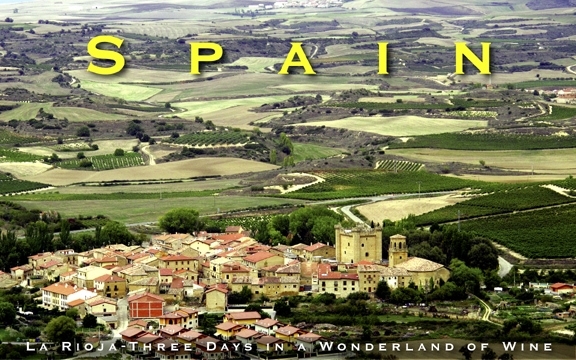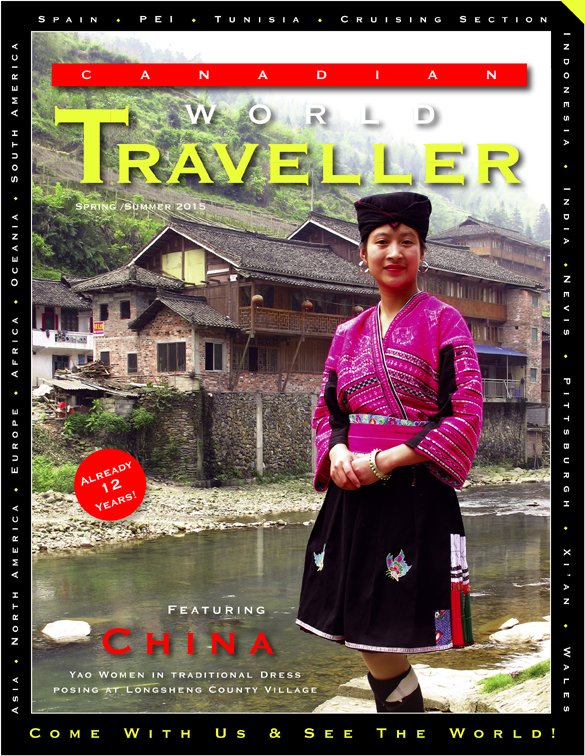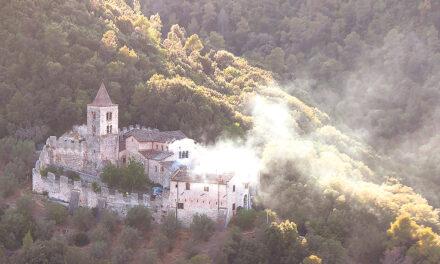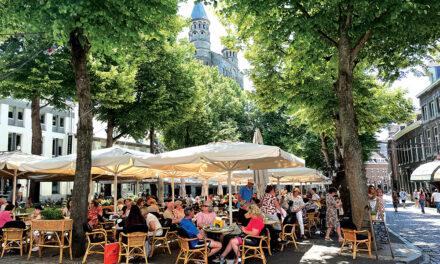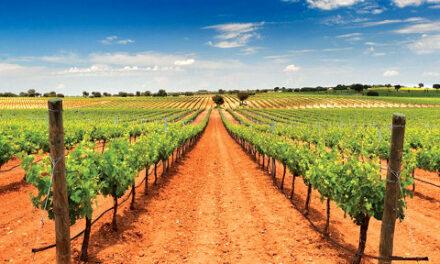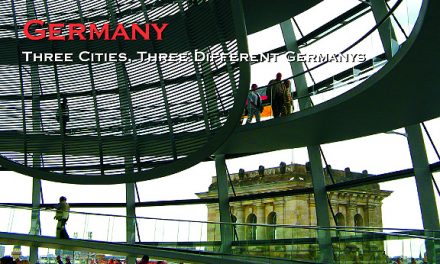Spain
La Rioja-Three Days in a Wonderland of Wine
Article & Images by Michael Morcos

We spent three heady days in Rioja, enjoying the beautiful rolling landscapes, charming medieval hamlets and exquisite wines of this magnificent region of northern Spain. The towns were small, but each had smells, colours and flavors that overload the senses.
The towns we visited were all very clean and well kept and we were fortunate to have arrived during harvest time. Most of Rioja is used for growing wine grapes and the wines made are found throughout the world.. The wine country is divided into three regions- Rioja Alta (where the old “chateaux” are located), Rioja Alavesa (in the Basque Country and home to some of the prettiest hamlets) and Rioja Baja.
Our first day was spent in the capitol Logrono. Even after a long journey from home, I could not wait to explore this city and it was love at first sight!
It was a quiet Sunday, and the locals were out in full force enjoying the day with their families.
My stops included the magnificent Catedral de Santa María de la Redonda. Built as a Gothic church, it steadily grew into a full-blown cathedral in the 16th century and is a testament to the architects of the day. Carmen Park is one of the most beautiful in the city with a wide array of animals and plants, including many types of ducks and birds.
What really won me over was the Town Square. Designed by architect Rafael Moneo and located on the Avenue of Peace, the modern Town Hall is in a large plaza where artists, musicians and public festivals are welcome throughout the year.
We also had the pleasure of visiting a traditional, third generation wine bag maker. He was so good and busy that he could not meet demand as his products were very popular with Spaniards and tourists alike.
The town really comes to life in the early evening as the crowds come out to participate in a unique kind of pub crawl. Though lots of red wine is consumed, the real deal is the food. Instead of a big sit down dinner, the locals (and tourists) go from place to place tasting different restaurant / bar’s special Pintxos (similar to, but wrongly known as, tapas). There are dozens of places to see and taste in a very small area (few blocks).
Our evening started at Calle de Laurel, where the amount of Pintxos bars was unbelievable! Almost 50 are packed into a single block about the size of football field. I counted 12 in my first street!
They also had a wine and food expert, a true magician when it came to paring foods with certain wines – and he was Merlin the magnificent! We were taught one trick – how to make food and wine taste even better. We learnt that by blocking our noses while tasting the food or wine, and then releasing it to have air flow in a sudden rush… it was amazing and it really worked. We could all taste the most dominate flavour right away.
The restaurants are quite different and unique, often only offering a special or 2 of the day. Limited menu, maximized taste. Our dinner was served at Bar Soriano, whose speciality (maybe the only thing they offer) was grilled mushrooms. A family run business; we met three generations who were working very hard just to meet the large demand of the awaiting crowds! When I asked what the main ingredient was, the answer I received was that it was a secret that would never be divulged!
And talk about flavors! Although any ingredient can be put on the small breads, but those most commonly found include fish like hake, cod, and anchovy,as well as tortilla de patatas or stuffed peppers, and croquettes. Pintxos can be very sophisticated sometimes, and can be very elaborate or expensive fish, seafood, or meats.
My personal, all-time favourite and a must eat in Spain is the cured Jamon (ham) made with the back leg of a certain breed of pig!
The following day we visited the town of Haro. Charming, quiet and clean, this village will stay in my heart forever. It’s architectural heritage including the main entrance of the Santo Tomás Church, the work of Felipe Vigarny, and the old town, which was declared a Historic-Artistic Site in 1975 are just a few of the treasures here. One of Haro’s biggest claims to fame is that it was the first town in Spain to have electric street lighting!
We stayed at the historic Hotel Los Agustinos, which was an old convent, then a prison and a mental institute before becoming the 4 star hotel it is today. The courtyard is covered by a glass roof and it is known as one of the best places to stay in Haro.
The next day we visited the Cune wine estates which are situated in a very clean historic building. The wine tasting was the best part and they treated us to some delicious and very old vintages. Oddly enough, the wine cellar was something from a Vincent Price horror film, very dark, musty smelling and full of spider webs…perfect to visit.
As a contrast, we visited a young and modern winery-hotel-restaurant called Finca Los Arandinos. Located on top of a hill with a magnificent view of the vineyards, the building was brand new, and had very avant-garde hotel rooms. After a great lunch, we were treated to a wine wrap / massage – it was so relaxing and invigorating that I fell asleep!
In the following days we would visit the Santo Domingo de la Calzada Cathedral and the famous Monasterios of Yuso and Suso in San Millán de la Cogolla.
The Cathederal has always been linked to The Pilgrimage of St. James and there were many hikers on the St. James path. There is a legend of a German Pilgrim called Hugonell who was walking to Santiago with his parents. They decided to rest at an inn in Santo Domingo de la Calzada, and the owner’s daughter fell in love with him. When spurned, she framed him for robbery and he was hung for the crime. His parents continued the pilgrimage, and upon their return, they found their son still hanging in the gallows – miraculously alive. “Santo Domingo brought back me to life, please go to the Mayor´s house and ask him to take me down”. The incredulous Mayor, who was preparing to have dinner with friends, responded: “That boy is as alive as these two roast chickens we are about to eat,” and suddenly, the chickens came to life, sprouted feathers and beaks and began to crow, and so, to this day there is a saying about the town which goes: “Santo Domingo of the Way, where the roosters crow after being roasted”.
The trip through the past continued at the Monasterios of Yuso and Suso, where it is said that the Castilian (Spanish) language was born. Well preserved historic buildings and storied past were ever-present, and date back to the 6th century!
The last meals of the trip were spent at two very nice Michelin Star restaurants, the first being Venta Moncalvillo where food, presentation and atmosphere are all ingrediants to peeper your dining experience! The head Chef met with us and gave a tour around the garden where they grow their own food – his passion for what he was doing was infectious.
The evening would bring a second meal at yet another Michelin restaurant, the Echaurren Hotel Gastronomico, which was also where we were staying for the night.
The restaurant is nestled in the fun town of Ezcaray, which offers cultural eventsthroughout the year Festival International de Jazz de Ezcaray, the Mycological Conference in the fall, its classical music season, its carnival and many other celebrations to enjoy.
The restaurant owners, Marisa and Felix, are the fourth generation of the family and received top honors for their restaurant, including the National Gastronomy Award for Best Chef and their sons Francis and Joseph Felix, are the fifth generation of the family and are guiding the establishment into the twenty-first century.
The next morning we were up and out very early, this was going to be a perfect ending to a perfect tour of Riojas!
I can think of no better way to say goodbye than in a hot-air ballon ride over the breathtaking countryside and beautiful towns of Riojas. The conditions were perfect, and we were greeted by many locals with a smile and a wave.
It was hard to wake from this lovely Rioja dream!
Visit: www.spain.info/en_CA/
Click on cover to view published article

